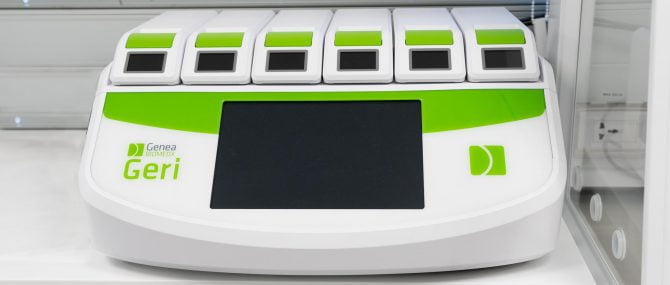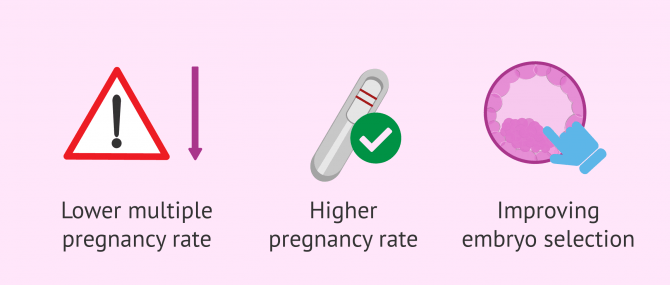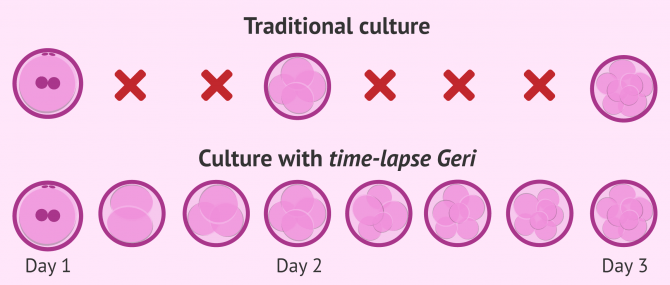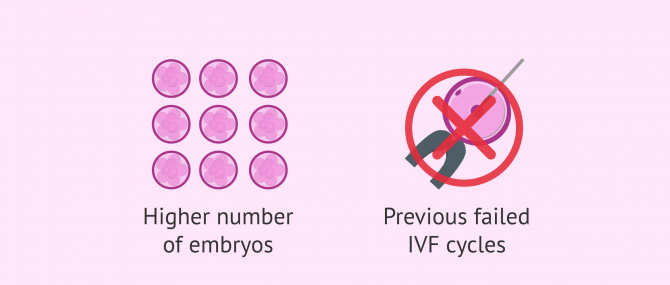The Geri is a state-of-the-art incubator that allows the observation of embryos at all times, thus facilitating embryo selection. This incubator has been a revolution in the field of assisted reproduction since it allows the evaluation of embryos at any time of the day without altering their culture conditions.
Embryo culture with Geri facilitates the work of selection by the embryologist and also increases the probability of pregnancy. In addition, this incubator reduces the multiple pregnancy rate.
Therefore, the Geri system offers numerous advantages for fertility treatments.
Provided below is an index with the 7 points we are going to expand on in this article.
- 1.
- 1.1.
- 2.
- 2.1.
- 3.
- 4.
- 4.1.
- 4.2.
- 4.3.
- 5.
- 6.
- 7.
Geri Incubator with Time-LapseTechnology
The Geri is a new and modern incubator that has the time-lapse which means that the embryos can be monitored at any stage of development without having to be removed from the incubator.
It is a device that contains 6 high-resolution cameras, each with an individual microscope, to capture images continuously. In particular, the Geri system allows the analysis of the embryos every 5 minutes and the observation of up to 11 different focal planes.
How does the Geri incubator look like?
The Geri incubator consists of six individual compartments for the development of the embryos of up to 6 patients. This way, when the embryos are extracted from a patient, it does not affect the rest.
In addition, the compartments have a sandwich opening and are very small in size. Each one of them has its own sensors to control the cultivation conditions, avoiding any alteration and recovering the optimal conditions quickly and efficiently.
Another model of this incubator is the Geri plus, an incubator with built-in software for the new version of EEVA Test. It is a program that allows us to predict which embryos will have the greatest potential for implantation and, therefore, the greatest probability of generating a pregnancy.
Advantages of the Geri Incubator
Embryos obtained in an in vitro fertilization (IVF) process can be individually and continuously monitored throughout their development thanks to the Geri incubator. This is a great advantage, as it allows for better embryo selection at the time of transfer to the woman's uterus.
Other advantages offered by embryo culture in the Geri incubator are the following:
- Decreases the chance of multiple pregnancy.
- Increases the rate of implantation.
- It favours the development of the embryos up to blastocyst, since it improves the culture conditions.
- It provides information about the embryos without the need to take them out.
In summary, the Geri incubator provides the ideal culture conditions for the development of the embryos, allowing the success of assisted reproduction treatments to be increased.
Better embryo selection
Before the appearance of the Time-Lapse technology, the selection of embryos was made taking into account the observation of them once a day and noting their morphological characteristics. Usually, this analysis is carried out on day 1, day 3 and day 5 of the embryonic development and aspects such as the number and size of the cells, the percentage of fragmentation, etc. are analyzed.
However, the Time-Lapse system allows the creation of a video of the embryonic evolution by capturing images every 5 minutes. This means that embryo selection is carried out on the basis of morphokinetic characteristics.
The information provided by the Geri incubator, or any other Time-Lapse incubator, will be critical in determining which embryos are most likely to result in a pregnancy.
Indication
The use of the Geri incubator is indicated for all types of patients undergoing IVF treatment, whether with their own eggs, donated eggs, and/or donor sperm.
Nonetheless, it is true that the Geri system is especially recommended when patients obtain a large number of embryos, as it may be more difficult to select the best embryos in a conventional way.
Another situation where embryo culture with Time-Lapse is advised is when patients have performed several unsuccessful IVF cycles.
FAQs from users
How much does it cost to culture embryos in the Geri incubator?
The price of embryo culture in the Geri will depend on each fertility center, although it usually ranges between 300 and 500 euros.
Some fertility clinics include the culture of embryos with Time-Lapse technology within the IVF budget, but in other cases, this is not the case. For this reason, it is essential to request a personalized and detailed budget for assisted reproduction treatment.
Are there other Time-Lapse incubators?
Yes, the most common Time-Lapse systems are currently classified into two types depending on the imaging system:
- Built-in image system
- Embryoscope, Geri, Miri and CCM.
- Standalone image system
- PrimoVisio and Eeva
Cada sistema Time-Lapse tiene sus propias ventajas y propiedades específicas, aunque disponer de cualquier información del desarrollo de los embriones permite una evaluación más precisa de los mismos. Así, se aumenta la tasa de implantación embrionaria y, por tanto, la probabilidad de embarazo.
What other types of incubators are available for embryo culture?
The first incubators for embryo culture were large and the embryos of all patients were stored in the same space. Therefore, when a patient's embryos had to be removed for microscopic viewing or transfer, the temperature and gas conditions were temporarily altered, and this could affect all the embryos.
More recently, "benchtop" or "sandwich" type incubators have been developed. These have individualized compartments for each patient, so that opening one does not affect the others. In addition, the culture conditions are much better than with the first incubators, as they work at low oxygen pressures, so they imitate the conditions of the human body much better. The difference between these incubators and the Embryoscope® or other types of time-lapse incubators is that they do not have a built-in camera, so if you want to monitor the development of the embryos you need to remove them from the incubator to look at them under the microscope.
Suggested for you
As we have commented throughout the article, the Geri incubator has Time-Lapse technology. If you wish to learn more about this system, you can visit the following link: What is time-lapse? - Improving in vitro embryo development.
On the other hand, and thanks to the Geri incubator, the rate of embryos reaching the blastocyst stage is higher. But when is it better to do the embryo transfer? In the following article, you have all the information: Day 5 vs. Day 3 Embryo Transfer - What Are the Pros & Cons?
We make a great effort to provide you with the highest quality information.
🙏 Please share this article if you liked it. 💜💜 You help us continue!
References
Alpha scientists in reproductive medicine and ESHRE special interest group of embryology: The Istanbul consensus workshop on embryo assessments: proceedings of an expert meeting. Hum Reprod 2011, 26:1270–1283.
Armstrong S. Time-lapse systems for embryo incubation and assessment in assisted reproduction. Cochrane Database Syst Rev. 2019 May 29;5:CD011320. doi: 10.1002/14651858.CD011320.pub4.
Borini A, Lagalla C, Cattoli M, Sereni E, Sciajno R, Flamigni C, Coticchio G: Predictive factors for embryo implantation potential. Reprod Biomed Online 2005, 10:653–668.
Del Gallego R, Remohí J, Meseguer M. Time-Lapse Imaging: The State of the Art. Biol Reprod. 2019 Feb 27. pii: ioz035. doi: 10.1093/biolre/ioz035.
FAQs from users: 'How much does it cost to culture embryos in the Geri incubator?', 'Are there other Time-Lapse incubators?' and 'What other types of incubators are available for embryo culture?'.






